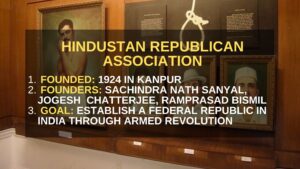The struggle for India’s independence witnessed various phases and strategies, ranging from moderate petitions to mass movements. However, when the Non-Cooperation Movement was suspended in 1922, young nationalists became frustrated with the non-violent approach. This led to the emergence of Revolutionary Nationalism, which adopted radical methods such as armed resistance, assassinations, and direct action against British colonial rule.
Revolutionary Nationalism 2.0 refers to the intensified phase of the revolutionary movement in India, where icons like Bhagat Singh, Ashfaqulla Khan, Ramprasad Bismil, and Roshan Singh led the fight with utmost bravery and sacrifice. Inspired by global revolutionary ideologies, this movement aimed to overthrow British rule through armed struggle.
Download notes of Non Cooperation Movement & Khilafat Movement
Factors Leading to the Rise of Revolutionary Nationalism
The rise of revolutionary activities in India can be attributed to several internal and external factors:
Internal Factors
- Discontent with Non-Cooperation Movement
- The sudden suspension of the Non-Cooperation Movement after the Chauri-Chaura incident (1922) disillusioned young revolutionaries.
- They felt that passive resistance alone could not achieve independence.
- Absence of Political Leadership
- Many youth felt that contemporary leaders failed to harness their revolutionary zeal.
- Disenchantment with Mahatma Gandhi’s non-violent strategy led to the rise of armed resistance.
- Government Repression and Exploitation
- British authorities used oppressive laws to crush any dissent, leaving revolutionaries with no peaceful avenue for protest.
- Rise of Socialist and Trade Union Movements
- The growth of socialist ideas influenced many revolutionaries who sought an egalitarian society free from exploitation.
External Factors
- Inspiration from International Movements
- The victory of Japan over Russia in 1905 showed that an Asian power could defeat a European empire.
- The Irish Republican Army’s violent struggle against British rule also influenced Indian revolutionaries.
- Russian Influence
- Indian revolutionaries were inspired by Russian nihilists and socialist movements advocating armed uprisings.
Major Revolutionary Activities in North India
1. Hindustan Republican Association (HRA)
- Founded in 1924 in Kanpur by Sachindra Nath Sanyal, Jogesh Chatterjee, and Ramprasad Bismil.
- Aimed to establish a federal republic in India through armed revolution.
- Kakori Conspiracy (1925):
-
- HRA members looted government treasury from a train in Kakori.
- Ashfaqulla Khan, Ramprasad Bismil, Roshan Singh, and Rajendra Lahiri were executed by the British.

2. Hindustan Socialist Republican Association (HSRA)
- Formed after the reorganization of HRA in 1928.
- Focused on socialist ideals and armed struggle against British rule.
Lahore Conspiracy Case (1928)
- Objective: Assassinate James Scott, responsible for Lala Lajpat Rai’s death during the anti-Simon Commission protests.
- Outcome: John Saunders was mistakenly killed instead.
- Revolutionaries Involved: Bhagat Singh, Rajguru, Sukhdev.
- Bhagat Singh’s famous slogans:
- Inquilab Zindabad! (Long live the revolution!)
- Down with Imperialism!
Bombing of the Central Legislative Assembly (1929)
- Bhagat Singh and Batukeshwar Dutt threw bombs inside the Delhi Assembly to protest against oppressive laws.
- The bombs were symbolic and caused no harm.
- Both were arrested, and Bhagat Singh used the trial as a platform to propagate Revolutionary Nationalism.
Jail Protests
- Jatin Das died on the 64th day of his hunger strike in 1929, leading to nationwide outrage.
Execution of Bhagat Singh (1931)
- Bhagat Singh, Rajguru, and Sukhdev were hanged on March 23, 1931.
- Their martyrdom inspired future generations of Indian revolutionaries.
Revolutionary Activities in Bengal
1. Chittagong Armoury Raid (1930)
- Led by Surya Sen (Master Da).
- Plan to capture British arms and overthrow colonial rule.
- The revolutionaries successfully raided the armoury and hoisted the Indian flag.
- Surya Sen was captured and hanged in 1933.
2. Peshawar, Kanpur & Meerut Conspiracy Cases
- Peshawar Conspiracy Case (1922-23): Muslim revolutionaries trained in Moscow were arrested upon return.
- Kanpur Bolshevik Conspiracy (1924): British arrested Indian communists for spreading socialist ideas.
- Meerut Conspiracy Case (1929): Trade unionists were arrested for organizing workers’ strikes.
Decline of the Revolutionary Movement
- The execution of Chandrasekhar Azad (1931) and Surya Sen (1933) marked a decline in armed revolutionary activities.
- Gandhi’s opposition to violence shifted the focus towards mass movements like the Civil Disobedience Movement.
- Many revolutionaries were imprisoned or executed, leading to a decline in militant nationalism.
The Revolutionary Movement played a significant role in India’s struggle for independence. It inspired countless youth to sacrifice their lives for the country’s freedom. The secular nature of this movement and women’s participation (e.g., Kalpana Dutta, Pritilata Waddedar) added to its importance.
Download notes of Civil Disobedience Movement in India
Though it did not directly lead to independence, it fueled the nationalist spirit and pressured the British government to consider Indian demands. The ideas of socialism, equality, and nationalism introduced by Indian revolutionaries later shaped independent India’s political framework.
The slogan “Inquilab Zindabad” continues to echo as a symbol of resistance and patriotism.


